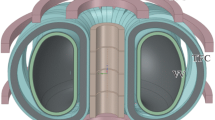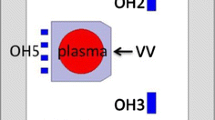Abstract
Plasma energy confinement time is one of the main parameters of tokamak plasma and Lawson criterion. In this paper we present an experimental method especially based on diamagnetic loop (toroidal flux loop) for measurement of this parameter in presence of resonance helical field (RHF) in IR-T1 tokamak. For this purpose a diamagnetic loop with its compensation coil constructed and installed on outer surface of the IR-T1. Also in this work we measured the plasma current and plasma voltage from the Rogowski coil and poloidal flux loop measurements. Measurement results of plasma energy confinement time with and without RHF (L = 2, L = 3, L = 2 & 3) show that the addition of a relatively small amount of RHF could be effective for improving the quality of tokamak plasma discharge by flatting the plasma current and increasing the energy confinement time.
Similar content being viewed by others
Avoid common mistakes on your manuscript.
Introduction
Precise determination of the energy confinement time is important in tokamaks experiments especially in fusion programs. Magnetic diagnostics, in particular diamagnetic loop (toroidal flux loop) are commonly used in tokamaks to measure the variation of toroidal flux induced by the plasma and then poloidal Beta and energy confinement time [1–6]. In this paper we present experimental study of effects of resonant helical field (RHF) (RHF is an external helical magnetic field which can improve the tokamak plasma confinement) on measurement of energy confinement time in IR-T1 tokamak, which it is a small, low Beta and large aspect ratio tokamak with a circular cross section. Measurement of the energy confinement time using diamagnetic effect will present in Sect. 2. RHF setup on IR-T1 tokamak will present in Sect. 3. Experimental results of effects of RHF on Shafranov shift will present in Sect. 4. Summary and conclusion are also will present in Sect. 5.
Determination of Plasma Energy Confinement Time Especially Based on Diamagnetic Effect
Diamagnetic loop measure the toroidal diamagnetic flux for the purposes of measurements of the plasma parameters such as poloidal Beta and thermal energy of the plasma. The toroidal flux that produced by the plasma is related to the total perpendicular thermal energy of the plasma. This diamagnetic flux is usually measured with the diamagnetic loop. It is usually a single wire which circling the plasma column either inside or outside of the plasma vacuum chamber. Intrinsically this loop will also pickup the toroidal magnetic flux from the toroidal field coil and any current circulating in the poloidal plane, in particular toroidal field coil current, eddy currents in the conducting vacuum chamber induced during transient changes in the plasma energy and plasma current. In other words, the diamagnetic loop consist of a simple loop that links the plasma column, ideally located in a poloidal direction in order to minimize detecting the poloidal field. In cases of the ohmically heated tokamaks (low beta) where the plasma energy density is small compared to the energy density of the magnetic field, the change in the total toroidal magnetic flux is small. Therefore a reference signal equal to the vacuum toroidal magnetic flux is usually subtracted from it, giving a net toroidal flux equal to the diamagnetic flux \( \Updelta \Upphi_{D} \) produced by the circular plasma. Relation between the diamagnetic flux and the poloidal beta derived from simplified equilibrium relation [2–4]:
where \( \Updelta \Upphi_{D} = \Upphi_{\text{Total}} - \Upphi_{\text{vacuum}} , \) and \( \Upphi_{\text{vacuum}} = \Upphi_{\text{T}} + \Upphi_{\text{O}} + \Upphi_{\text{V}} + \Upphi_{\text{E}} \), and where \( B_{\phi 0} \) is the toroidal magnetic field in the absence of the plasma which can be obtained by the magnetic probe, I p is the plasma current which can be obtained by the Rogowski coil, ΦT is the toroidal flux because of toroidal field coils, ΦO and ΦV are the passing flux through loop due to possible misalignment between ohmic field and vertical field and the diamagnetic loop and ΦE is the toroidal field due to eddy current on the vacuum chamber. These fluxes can be compensated either with compensation coil or fields discharge without plasma. It must be noted that compensating coil for diamagnetic loop is wrapped out of the plasma current, and only the toroidal flux (which is induced by the change of toroidal field coil current when plasma discharges) can be received. As shown in Eq. 1 the diamagnetic loop signal contains two parts, plasma diamagnetic flux and the vacuum toroidal flux. So the diamagnetic flux \( \Updelta \Upphi_{D} \) caused by plasma current can be measured from the diamagnetic loop and compensating coil using subtraction.
If we want to have a determination of the volume averaged plasma kinetic pressure \( \left\langle p \right\rangle \), it is can be measured directly from the definition of the poloidal Beta:
where a is the plasma minor radius.
For measurement of the plasma thermal energy we start from the plasma state equation:
where subscript i indicate the plasma species i, and E indicate the plasma thermal energy density, therefore the plasma thermal energy U, and also plasma temperature is obtained:
where V is the plasma volume. If we have the quasi neutral plasma density from the Langmuir probe measurements, then we can find the plasma averaged temperature from Eq. 4.
For determination of the plasma energy confinement time which defined by equation:
where τ E is the plasma energy confinement time, and P Ohmic is the rate of input heating power. Rearranging Eq. 5, the ohmic heating power is:
If the plasma is in thermal equilibrium (\( \dot{L} = 0 \), and \( \dot{I} = 0 \)), then we have:
Also if dU/dt is not negligible, then from Eqs. 5, 7 we have:
In the flat region of the tokamak plasma current, time variations is very small and Eq. 7 is indefeasible. Therefore according to above discussion we can find the energy confinement by the diamagnetic loop and with helping the Rogowski coil and poloidal flux loop. Experimental results will present in Sect. 4.
Resonant Helical Field (RHF) Setup on IR-T1 Tokamak
The RHF is an external helical magnetic field which can improve the tokamak plasma confinement. In the IR-T1, This field is produced by two winding with optimized geometry conductors wound externally around the tokamak chamber with a given helicity. The minor radius of these helical windings are 21 cm (L = 2, n = 1) and 22 cm (L = 3, n = 1) and also major radius is 50 cm (see Fig. 1). In this experiment, the current through the helical windings was between 200 and 300 A, which is very low compared with the plasma current (32 kA).
Experimental Results of Effects of RHF on Energy Confinement Time
In order to determination of the plasma energy confinement time, we needed for measurement of the poloidal Beta, plasma current, and plasma voltage. Therefore we constructed and installed a diamagnetic loop with its compensation coil on outer surface of IR-T1, and then poloidal Beta measured. Plasma voltage and plasma current are also measured using poloidal flux loop and Rogowski coil, respectively.
On the other hand, we experimented in presence of RHF with L = 2, L = 3, and L = 2 & 3 modes in IR-T1 tokamak plasma. Experimental results show that effects of presence of RHF, especially L = 2 and L = 3 modes are flatting the plasma current and increasing the energy confinement time as shown in Figs. 2, 3, 4, 5.
Summary and Discussion
Plasma energy confinement time is one of the main parameters of tokamak plasma and Lawson criterion. In this paper an experimental method especially based on diamagnetic loop (toroidal flux loop) for measurement of this parameter in presence of RHF in IR-T1 tokamak is presented. For this purpose a diamagnetic loop with its compensation coil constructed and installed on outer surface of the IR-T1. Also in this work we measured the plasma current and plasma voltage from the Rogowski coil and poloidal flux loop measurements. Measurement results of plasma energy confinement time with and without RHF (L = 2, L = 3, L = 2 & 3) show that the addition of a relatively small amount of RHF could be effective for improving the quality of tokamak plasma discharge by flatting the plasma current and increasing the energy confinement time.
Change history
18 July 2024
This article has been retracted. Please see the Retraction Notice for more detail: https://doi.org/10.1007/s10894-024-00449-0
References
J. Wesson, Tokamaks (Clarendon, Oxford, 1997)
E.J. Strait et al., Fusion Sci. Technol. 53 (2006)
I.H. Hutchinson, Principles of Plasma Diagnostics (Cambridge University Press, Cambridge, 1987)
A. Salar Elahi et al., J. Fusion Energ. (2009), doi:10.1007/s10894-009-9198-x
J.P. Freidberg, Ideal MHD (Clarendon, Oxford, 1987)
A. Hojabri et al., 32nd EPS, Tarragona, Spain, ECA 29C, P4.064 (2005)
Author information
Authors and Affiliations
Corresponding author
Additional information
This article has been retracted. Please see the retraction notice for more detail: https://doi.org/10.1007/s10894-024-00449-0
About this article
Cite this article
Salar Elahi, A., Ghoranneviss, M. RETRACTED ARTICLE: Measurement of Plasma Energy Confinement Time in Presence of Resonant Helical Field in IR-T1 Tokamak. J Fusion Energ 28, 394 (2009). https://doi.org/10.1007/s10894-009-9210-5
Published:
DOI: https://doi.org/10.1007/s10894-009-9210-5









